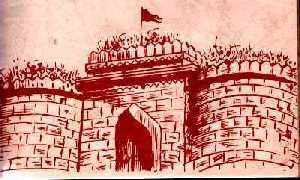|
|
|
Home History News Matrimonials
HISTORY

Click here to read Preview of Books on History of Our Community
Click here to read A FACTSHEET on Our Community
Some Historical Excerpts on Our Community
Extract from the South Kanara District Manual, Vol. I - 1894 Edition
"Servegaras, Koteyawas, Ramakshathriyas or Ramarajakshathriyas are said to be a branch of the Konkan marathas of Goa from whence they were invited by the Lingayat kings of Nagara to serve as warriors and to defend their forts ( 'KOTE' ) whence the alternative name of Koteyawa. The mothertongue of the Servegaras of South Kanara is Canarese, while their brethren in the north speak Konkani. They have now taken to cultivation, but some are employed in the Revenue and Police Departments and a few are shopkeepers. The name Servegara is derived from Canarese "Serve" meaning an army. They wear the sacred thread. They eat meat but do not drink. Their titles are Nayak, Aiya, Rao and Sheregar.
Their original home is said to be Vijayadurga, one of the ancient forts north of Goa. And the men had enlisted largely in the armies of the Vijayanagara kings and also served the Lingayat kings of Nagara and Keladi chiefs and defended the numerous forts built by them in the Canarese country. They seem to have also served Hyder and Tippu and after their defeat by the British, settled down as cultivators."
Castes & Tribes of South India by Thurston - 1909
"The Servegaras are a caste found in South Kanara and to a small extent in Bellary. They are said to a branch of the Konkan marathis of Goa from they were invited by Lingayat kings of Nagara to defend their forts ( 'KOTE' ), whence the alternative name of Koteyava (Kotegara). Another name for them is Ramakshathri."
Gazetteer of the Bombay Presidency Vol. XV Part I - Kanara -1883 - Chapter III
"SHEROGARS number 3070 of whom 1582 are males and 1488 females are found on the coast of Honnavara and Kumta. They are said to have come from Goa and to be a branch of Konkan marathas who have Sawant, Naik, Nayaka, Serugar and other surnames. Their hometongue is Konkani spoken with a Canarese accent and much mixed with Canarese words. Men's names generally end in "Ayya" as Purushayya, Appayya, Santayya and women's names in Amma as Nagamma etc.
Most of the men are tall, regular featured and wheat coloured. Some are fair and women are fairer and better made than men and much like Saraswat Brahmin women. They live in large families. Their common food is rice, fish and vegetables but they eat chicken and mutton. They drink no liquor. They were formerly warriors but now most are farmers and cattle-owners.
The men wear the sacred thread. The heads of widows are not shaved. Social disputes are settled by committees of the caste under the presidency of the headman. Each village has its headman called 'Budvant'.
They are skilful cultivators and are likely to rise in importance as they send their boys to schools and are continuously improving their conditions."
Sheregars of North Kanara (Source:- North Kanara District Gazetteer)
"The Sherogars are originally warriors.Their ancestors are said to have come from Goa and are described as a branch of Konkan marathas.Their mothertongue is Konkani. They were formerly warriors mostly engaged by the Keladi rulers in their forts. They are chiefly found in Honnavar and Kumta taluks. They call themselves Ramakshathriyas, and their kinsmen in Dakshina Kannada speak Kannada."
"To man the forts built by them, the Keladi rulers brought warriors from outside. They are called Shervegars and are found even today in places like Chandavar, Mirjan etc."